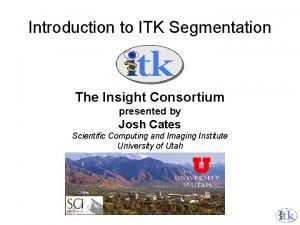Improving LanguageUniversal Feature Extraction with Deep Maxout and

- Slides: 1

Improving Language-Universal Feature Extraction with Deep Maxout and Convolutional Neural Networks Yajie Miao Florian Metze Language Technologies Institute, School of Computer Science, Carnegie Mellon University ymiao, fmetze@cs. cmu. edu 1. Introduction 3. Sparse Feature Extraction • DNNs become the state of the art for speech recognition. DNNs provide an architecture particularly suitable for multi-lingual and cross-lingual ASR. • DNN-based language universal feature extraction (LUFE) was proposed in [1]. A multilingual DNN can be learned with hidden layers shared across languages. Each language has its own input features and softmax output layer. • On the new language, the shared hidden layers act as a deep feature extractor. Hybrid DNN models are built over feature representations from this extractor. This realizes cross-language knowledge transfer. 5. Experiment Results and Observations 1. Maxout Networks for Sparse Feature Extraction • Maxout networks [3] partition the hidden units into groups. Each group outputs the max value within it as the activation. • After the maxout network is trained, sparse representations can be generated from any of the maxout layers via a non-maximum masking operation. • Non-maximum masking only happens during the feature extraction stage. The training stage always applies max-pooling. • Goal: improve LUFE via maxout and convolutional networks; generate sparse and invariant feature representations Lang 1 softmax Lang 2 softmax Lang 3 softmax … … Source Feature Extractor Hybrid DNN Target … Lang 1 input Lang 2 input maxout network maxout layer non-max masking 2. More Comparison • Rectifier networks [4] also generate zero-sparsity features Target Lang 2. LUFE with Convolutional Networks • CNN inputs: 11 frames of 30 -dim fbank • Convolution only on the frequency axis • Network structure: 11 x 30 100 x 11 x 5 200 x 100 x 4 1024: 1024 • Pooling size of 2 Features • We report WERs(%) on a 2 -hour testing set of Tagalog. • p. Sparsity is computed as an average over the entire Tagalog training set Models WER% p. Sparsity Monolingual DNN Monolingual CNN 70. 8 68. 2 ----- DNN-LUFE CNN-LUFE 69. 6 67. 1 21. 3 20. 4 LUFE with CNNs Rectifier-LUFE Maxout-LUFE 68. 2 67. 5 10. 7 17. 7 LUFE with Maxout-CNN-LUFE 65. 9 16. 6 CNN+Maxout Monolingual Baseline • Application of LUFE improves the monolingual DNN consistently • Quantitatively measure sparsity via the popularity sparsity metric [5]. Given one speech frame, we assume fm is the feature representation: Lang 3 input • On the target language Tagalog, the identical DNN topology is used for hybrid systems over different feature extractors. p. Sparsity = • The CNN extractor outperforms the DNN extractor by 2. 5% absolute WER • Maxout networks generate sparse features and better WERs. Rectifier networks output even sparser features but worse WERs. Over-sparsification may hurt speech recognition performance!! • Combining maxout and CNN results in the best feature extractor 3. Combination of CNN and Maxout Networks • Keep the convolutional layers unchanged. The fully connected layers are replaced by maxout layers • This generates both invariant and also sparse feature representation 4. Experimental Setup • BABEL corpus: Base Period languages Tagalog (IARPA-babel 106 -v 0. 2 f) Cantonese (IARPA-babel 101 -v 0. 4 c) Turkish (IARPA-babel 105 b-v 0. 4) Pashto (IARPA-babel 104 b-v 0. 4 a. Y) Statistics Target Source Tagalog Cantonese Turkish Pashto # training speakers 132 120 121 training (hours) 10. 7 17. 8 9. 8 dict size 8 k 7 k 12 k 8 k # tied states 1920 1867 1854 1985 6. References [1] J. Huang, J. Li, D. Yu, L. Deng, and Y. Gong, “Cross-language knowledge transfer using multilingual deep neural network with shared hidden layers, ” in Proc. ICASSP, 2013. [2] T. N. Sainath, A. Mohamed, B. Kingsbury, and B. Ramabhadran, “Deep convolutional neural networks for LVCSR, ” in Proc. ICASSP, pp. 8614 -8618, 2013. [3] Y. Miao, F. Metze, and S. Rawat, “Deep maxout networks for low-resource speech recognition, ” in Proc. ASRU, 2013. [4] X. Glorot, A. Bordes, and Y. Bengio, “Deep sparse rectifier neural networks, ” in Proc. AISTATS, 2011. [5] J. Ngiam, P. Koh, Z. Chen, S. Bhaskar, and A. Y. Ng, “Sparse filtering, ” in Proc. NIPS, 2013 Acknowledgements This work was supported by the Intelligence Advanced Research Projects Activity (IARPA) via Department of Defense U. S. Army Research Laboratory (Do. D / ARL) contract number W 911 NF-12 -C-0015. The U. S. Government is authorized to reproduce and distribute reprints for Governmental purposes notwithstanding any copyright annotation thereon. Disclaimer: The views and conclusions contained herein are those of the authors and should not be interpreted as necessarily representing the official policies or endorsements, either expressed or implied, of IARPA, Do. D/ARL, or the U. S. Government.

